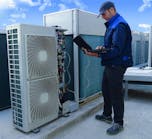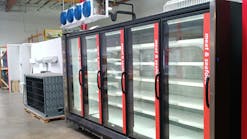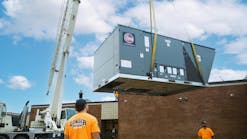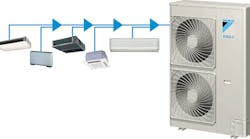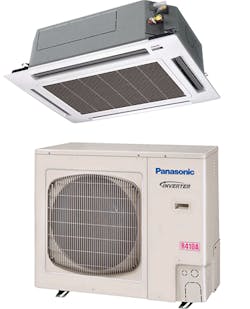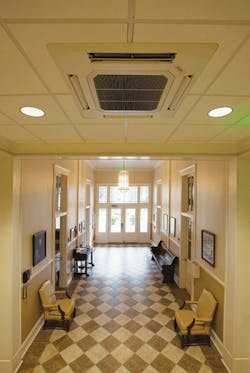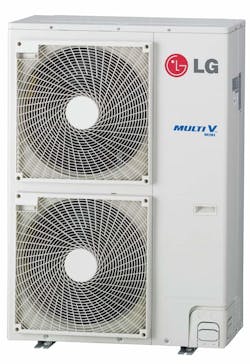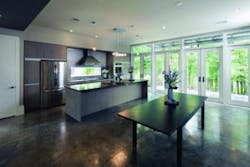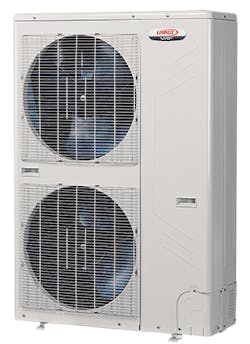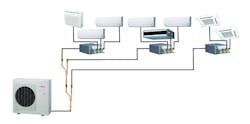Variable refrigerant flow (VRF) — or Daikin’s variable refrigerant volume (VRV) — HVAC systems are changing the HVAC industry in a variety of ways.
• VRF technology is ideally suited to answer societal demands for increased energy efficiency from large appliances.
• Indoor delivery components of VRF systems are designed to be pleasing to the eye in indoor settings.
• VRF continues to offer HVAC contractors, homeowners, and building owners installation options not possible with traditional ducted products.
This article will focus on “mini” VRF units that serve multiple areas in homes and buildings, not to be confused with a “mini-split” product that serves a single room, or the largest VRF rooftop units.
The mini VRF is a single-phase inverter product that provides heating and cooling to multiple rooms or office spaces from a single outdoor unit. Sources tell ContractingBusiness.com these products are bridging the gap between the smallest single mini-split home installations to light commercial buildings that often don’t have three-phase electricity.
“VRF systems, such as the Panasonic Mini-ECOi, offer space saving capabilities, energy efficiency, zone control, heat recovery, modulation and diversity, and reduced installation costs,” says Malcom Persaud, senior manager, product and market development, Panasonic Air Conditioning Group.
“VRF goes beyond the idea of one thermostat controlling heating and cooling across one structure, and blowing air into all rooms, regardless of whether they’re occupied or not,” Persaud says.
An inverter-driven system that is self-modulated based on load gives you an added dimension of energy savings.”— Malcolm Persaud, Panasonic
“If you leave the bedroom for the day, or if your children go off to college, why should you maintain those rooms at the same temperature as when they’re occupied? he asks. “Let’s heat and cool only the occupied areas, and set back the rest of the house.”
If a home’s bedrooms and other living areas are all connected to a single outdoor unit, comfort can be controlled in each area independent of the other. That’s the mini VRF advantage in a nutshell: control of multiple living or work areas at different temperatures and at different times of day, without the use of an added ductwork zoning apparatus.
“And every time I add another indoor unit and break my home into smaller zones I can further reduce the monthly operational cost,” Persaud says. “An inverter-driven system that is self-modulated based on load gives you an added dimension of energy savings.”
Persaud says mini VRF systems provide three “dimensions of savings.”
“The first dimension of savings is achieved from the controlled zoning, in which you setback the temperature in unoccupied rooms,” he says.
“The second dimension is achieved by using an inverter system that modulates cooling or heating capacity based on load, or ‘load matching.’ It’s like a church on Christmas day or a retail location on a weekend, when attendance is at maximum, and the comfort system operates at full tilt. When occupancy is lower, the system runs at part-load capacity.”
Finally, Persaud says the third dimension of energy savings is achieved in the way refrigerant refrigerant flows inside the coil.
“The coil does not experience high superheat or high subcooling. Generically, it’s the digital controls that control the amount of refrigerant flow under these conditions. Specific parameters are met for specific conditions,” Persaud explains.
Haier America has significantly increased its presence in the U.S. HVAC market, beginning with a solid showing at the 2015 AHR Expo. Its leading VRF mini product is the FlexFit Multi-Zone Solution.
The FlexFit range of products allows for mixing and matching of the same indoor units to both single-zone and multi-zone outdoor units, effectively reducing the time and cost of inventory management. The FlexFit modular system allows for optimal ductless pairings between indoor and outdoor units operating off of the single DC inverter-driven rotary compressor.
Sixteen units can be combined to create more than 1,000 energy-efficient HVAC solutions, designed for cost-effectiveness.
“With FlexFit, indoor units can be mixed and matched to any of Haier’s single or multi-zone outdoor units, providing a solution for almost any ductless AC need. This built-in flexibility lets distributors and contractors reduce inventory up to 50% by combining Haier’s ductless products. There’s a fit for virtually every home,” says Gina Copeland, Haier American senior vice president, air quality.
The FlexFit method also streamlines product inventory.
“A distributor or contractor can match any indoor unit by using our FlexFit outdoor unit,” Copeland says.“Distributors don’t need to stock a particular indoor unit. They can match any of our indoor units to this outdoor unit as the capacity lines up. If they arrive on the jobsite and have an application that calls for them to go to a different capacity size on the indoor or the outdoor unit, they don’t have to exchange the system. All they have to do is replace it with a different indoor or outdoor unit. This saves on installation cost and time,” she explains.
FlexFit includes a high wall unit, an indoor slim duct that is only seven inches high, or a ceiling cassette. Each has its own advantages, depending on where they’re located in the home or building.
Haier is reaching contractors through open-house presentations at the company’s new, Wayne, NJ headquarters, and through distributorships.
“We invite contractors in to speak with Haier experts about the brand, its competitive advantages, and the products and services we offer,” Copeland says.
Requisite product training is required — this includes off-site video training for contractors who can’t take the time to travel — followed by testing, prior to becoming a Haier-certified dealer.
RELATED ARTICLE: Field Notes on Commercial VRF
In the ‘Multi’ Zone
Mitsubishi refers to its offerings in the mini VRF category as “light commercial, multi-zone solutions,” says Kevin Miskewicz, senior manager, commercial marketing, Mitsubishi Electric US, Inc. Cooling & Heating Division.
“They offer the ability to have multiple heads on an outdoor unit, and go into a large, custom home space, with single-phase being the key feature,” Miskewicz says.
According to Miskewicz, a product such as Mitsubishi’s multi-zone solution can help contractors adapt to the many different project scenarios they encounter, and to the needs of different customer types.
“One of the biggest advantages to not only a mini-split or a large commercial VRF, as well as this in-between product, is the personalized comfort aspect they all provide,” Miskewicz says. “At a small office building, you now can put one of these systems outside, and have individual zones within that building that give a person in Office A or Conference Room B the ability to control
“And, through use of a centralized controller, they can tie in other aspects of the building operation, whether it be lighting or other mechanical systems, and put them on timers and setback also, so they save additional energy and money,” he says.
Using multi-zone systems to eliminate duct-related practices such as fitting dampers, definitely brings a time and labor saving,” Miskewicz continues. “If the contractor can wrap their head around that, they can profit off of these better than they would from a traditional, forced air system. They drive profit into the contractors’ businesses, once they determine the optimal business model to follow when installing them.”
Two Dynamics: Contractors & Customers
Miskewicz says Mitsubishi’s consumer research has found there to be two types of VRF customers.
“One is the consumer who wants to be educated when presented with a product they’ve not seen before. On the flip side, there are groups of consumers we’ve identified through our research who are willing to invest time in learning about VRF before the contractor visits them in their home or office,” he explains.
“Instead of a contractor walking in and proposing a solution as they’ve done for decades, more homeowners are calling contractors and posing a series of questions, such as, ‘Tell me how VRF will improve efficiency, and give me a more sustainable home.’”
Therefore, Miskewicz says, the wise HVAC contractor has to approach VRF mini proposals as question-and-answer consultative meetings, rather than one-sided, ‘I’m the expert, here’s the solution,’ scenarios.
Cost Competitive
VRF brings considerable cost advantages to home or small building comfort.
“If you take into account everything that goes into an HVAC system, including materials and time required to install it, to its actual operation, you’ll find VFR to be a very competitive, if not more competitive solution for either home or office, when compared to traditional systems,” Miskewicz says.
For retrofits with existing ductwork from the previous system, Mitsubishi has released the Multi-Position Air Handler, or MVZ. It allows the contractor using a VRF mini to use existing ductwork without heat transfer loss.
“It’s an example of expanding outside the single-zone category. This multi-position air handler takes the place of a traditional unitary system’s air handler, and allows you to tap into the existing ductwork, and provide you with the efficiencies of a Mitsubishi system as well as the zone capabilities within the home,” Miskewicz says. It includes the inverter compressor, which ramps up or down, depending on requirements.
Mitsubishi unveiled the MVZ at the most recent American Institute of Architects trade show.
Contractors must participate in training classes before installing these products.
“They must participate in a training class that we or our distributors conduct,” he explains. “It’s complex, and is a different setup from what they’re used to. We want to eliminate issues upfront, and provide information related to the most common troubleshooting scenarios. As ‘Diamond Contractors,’ they must know what they’re doing before they attempt a real installation.”
Well-informed Customers
LG’s offering in the mini VRF category is the Multi-V Mini, and it is also making its way into the comfort mainstream, as LG illustrates its benefits in residential and light commercial applications. As with Mitsubushi, LG also provided case study presentations to architects during the recent AIA conference.
LG sources say mini VRF is an important player in the new construction game.
“In our industry, the design engineer is the guy who decides to put the VRF on the drawings, but he’s often guided by the architect,” says Edouard Ferrier, applications engineer, LG Electronics.
To some extent we’re seeing more architects concerned with greener construction methods, where energy efficiency is a priority.
—Edouard Ferrier
“So, as much as we can inform architects, they seem to really like our products. Architects aren’t as technical as engineers, and are more concerned with appearance, the floor space or ceiling space it requires; and, to some extent we’re seeing more architects concerned with greener construction methods, where energy efficiency is a priority. Those are the topics we tend to talk about with architects, because they understand it,” Ferrier says.
Ferrier says architects and builders are also concerned about meeting increasingly more stringent energy codes.
RELATED ARTICLE: The VRF Revolution
Ferrier adds that to date, the mini VRF LG audience is impressed by the multiple-zone benefits that come with a non-ducted/one compressor unit.
“It’s appealing to a homeowner or building owner to allow up to nine zones, connected to one outdoor unit. A reduced amount of equipment means fewer things that require attention. Positioning is simpler for one outdoor unit than multiples,” Ferrier explains.
RELATED ARTICLE: Proud Green Home at Serenbe
LG offered a ‘Lunch and Learn’ program for architects attending the AIA conference, with credits for a course that gives architects an overview of VRF. Additionally, LG’s membership in the United States Green Building Council, combined with involvement in GreenBuild and organizations such as EnergyStar help it spread the word about the VRF’s many benefits.
It helps to know that today’s end-user customers are better informed, says Lorie Quillin-Bell, director of LG’s Go-to-Market Commercial Air Conditioning Division. That’s a great advantage when prospecting.
“The Internet has revolutionized the way consumers select products,” Quillin-Bell says. “They’re involved in the decision-making process, and consumers and contractors need to work together to determine the right product for them. The contact we’ve had with consumers indicates they’re asking better questions and becoming more aware of the technology and its advantages.”
LG’s required contractor training includes an online training program — the LG Learning Management System (LMS). However, on-site training is also required.
“The last phase of our training, before they become an ‘LG Excellence Contractor’ requires on-site training,” Quillin-Bell adds. “We think it’s very important for the contractor to touch, feel and interact with the product directly. We offer remote learning at our core training centers, and, at a number of partner academies at our distribution and representative partners across the U.S. We also offer training for our distributor channel partners, through the Technical Service Advisor program. We offer intensive training with distributors, so they can be in a position to support the contractor,” she says.
Daikin developed the world’s first VRV (variable refrigerant volume) system in 1982 for use in the European commercial market. Its concept was to circulate refrigerant through a building rather than chilled water. Daikin copyrighted the VRV nomenclature, while companies that later developed similar products adopted the name “variable refrigerant flow” (VRF). Daikin launched VRV globally in 1987, and since that time, has seen contractors select it more frequently for use in higher end residential and light commercial applications.
Chris Bellshaw, director of VRV marketing for Daikin, says Daikin’s VRV mini product — VRV III-S — was originally developed for limited space retail and smaller office applications operating on single-phase power. In fact, the ‘S’ in VRV III-S stands for “space saving.”
“After it was launched globally, we started to see it being used in higher-end homes, custom homes or town home applications, where they would have been using multiple systems, or a mechanized zoning system,” Bellshaw says.
“If we were to break the market down (all companies brands), including the smaller capacity multi systems and mini VRF products, we can see that the category grew by about 22% from 2013-2014,” he says. “When you break it down into the capacity sizes that are used for the mini-VRF category, that looks more like a 25-26% growth. You can see the larger sizes starting to grow at a faster rate as people start to adopt this technology into some of the higher end, more custom residential and light commercial spaces.”
The growth in the category is in part fueled by the market entry of traditionally ducted product manufacturers, combined with increased acceptance by contractors, engineers, and building owners. Dealers want new comfort solutions.
“Dealers have started to focus on more than first cost, with the added benefits of providing an energy-efficient zoning solution. They’re looking at payback, impact on construction, and comfort. Those contribute to growth.”
RELATED ARTICLE: Proven Technology, Specialized Solutions
The construction advantages of VRV/VRF mini products are attractive to all construction stakeholders.
“You don’t need large ductwork, which allows you to raise ceiling heights, or lower the overall height of the building. And, the single-phase electrical requirement is attractive,” he says. “In one building,” he recalls, “we saved 17,000 sq. ft. of mechanical room space. In a high-end home, what would have been a mechanical area became a pantry for the family. No matter the size of the building, VRV can save on construction costs and reclaim some space for the occupants.”
Samsung made a big impression at the last AHR Expo, in part due to its introduction in this “mini” category, the DVM-S Eco.
“The DVM-S Eco is a versatile HVAC system that allows one to turn a single outdoor unit into a whole-home comfort system. By allowing for the use of multiple types and quantities of air handlers, the Eco can address comfort issues in a few rooms or an entire house,” explains Brian Seiderman, director of marketing. The single phase DVM-S Eco outdoor unit can support up to nine indoor units, and is described as an ideal solution for residential and semi-commercial spaces.
“The ability to use a multi-position air handler in a single-zone or multi-zone configuration provides flexibility. The option of adding up to eight additional air handlers off of the same outdoor unit allows the homeowner to use one inverter-driven, variable speed system instead of multiple standard efficiency, builder grade 13- or 14-SEER systems. Multiple air handlers allows the homeowner to condition just the rooms they’re using versus the entire home, which saves on energy bills,” Seiderman says.
For heating needs, the heating capacity of the DVM-S Eco allows for maximum savings on winter energy bills, and 90+% heating output at low ambient conditions.
Samsung provides DVM-S series training at Quietside locations and a 16-module online course.
Advantages in Many Applications
Trane and American Standard acknowledge that VRF mini is “bridging the gap” between the largest and smallest non-ducted offerings, for use in custom homes and light commercial buildings.
“The single phase VRF mini is positioned well between the multi-splits and the three-phase VRF products. Most applications range from large homes to light commercial applications,” says Nick Shin, American Standard ductless portfolio manager.
Traditional ducted comfort products manufacturers might be playing catch-up with the VRF offering, but it hasn’t taken them long to become competitive.
Trane and American Standard units provide distinct zoning advantages: up to nine indoor units can heat down to -4F low ambient conditions with 80% heating capacities very efficiently." — Nick Shin
“Trane and American Standard units provide distinct zoning advantages: up to nine indoor units can heat down to -4F low ambient conditions with 80% heating capacities very efficiently, with ratings up to 18 SEER,” Shin explains.
“These can be used as retrofits in building and homes that don’t have ductwork or historic buildings that don’t allow duct work,” he adds. “Older government and school buildings are also good candidates, as are urban applications that require low sound and slim outdoor units for properties with zero lot lines.”
Trane and American Standard provide VRF training at multiple locations.
“We have training facilities in our company, we have built regional training facilities with our independent distributors and have certified them to train local installers. We also offer online introductory training as well,” he says.
Lennox has been actively marketing its VRF mini product offering for one year.
Chris Drury, vice president of sales for Lennox VRF, says contractors appreciate seeing a Lennox offering in the category.
“I think contractors realize the rigors we put into quality assurance and reliability. To know that our VRF product went through those same qualification processes, they know they can trust it,” he says.
But what about hardened pros who built their businesses on traditional ducted products?
“We’re seeing contractors realize that VRF is the future,” Drury says. “They want to get on board and diversify their portfolio of comfort offerings. Having VRF includes them in more unique opportunities, such as large, custom homes. When you come up against a zoning control challenge such as a large home with many rooms, VRF is the optimal solution for that type of application. Contractors know this is coming, and want to diversify, and be leaders in their markets.”
As others interviewed for this article have stated, Drury sees more VRF mini acceptance among product specifiers in commercial categories. For example, he says architects and consulting engineers are ‘getting it.’
“I had a great meeting with a very big engineer in the Dallas/Fort Worth area who does a lot of municipal work. Any chance they get, they’re talking to the end user customer about VRF. The engineering community and architects understand the benefits VRF can offer to clients,” he says.
“When you break it down, with the energy savings (especially if you’re designing around LEED specifications) you can’t ignore the value VRF offers for some buildings.”
Brendan Casey, commercial product manager for Fujitsu, says he sees whole-house VRF to be popular among all age groups, not just millennials. The product Fujitsu offers in this category is called the Hybrid Flex Inverter System — a 48,000 Btu, eight-zone comfort product.
“The HFI unit enables you to have up to eight indoor units connected to one outdoor unit. It does that by using a branch box. The expansion valve, which controls the amount of heating and cooling delivered to each indoor unit, is positioned inside the branch boxes. So you can have up to three of those branch boxes on one system. You can have one upstairs feeding three rooms upstairs, another feeding three rooms downstairs and perhaps two more in a basement,” he explains. “You only need to run two pipes from the outdoor unit to a central location on the first floor, with the branches running off of it.”
Casey says going from a three-zone to the eight-zone system was a big step for Fujitsu. It came to fruition in 2010, just as whole- house ductless was becoming more widely-accepted throughout the HVAC industry.
“Everything came together,” he recalls. “We had a good base of contractors who were already installing our systems, and a customer base who were using VRF for a single room, and wanted to have the eight-zone installed in their entire homes.”
Fujitsu dealers have also found VRF’s efficiency advantages to be a great ice breaker with consumers.
“It’s very popular for people who want to control temperature in each individual room. One room can be 70, another can be at 72. At night, the downstairs areas can be setback, and the bedrooms kept at a comfortable 70,” Casey says.
Fujitsu requires two full days of training at company headquarters in Fairfield, NJ.
The number of comfort options available to enterprising HVAC contracting firms continues to grow. The growth within this mini-VRF category alone is an exciting and challenging development for contractors seeking to have an alternative answer to every residential or light commercial comfort need.
